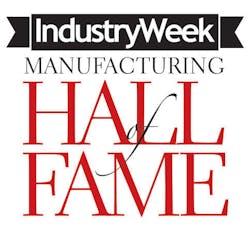Carl Deckard's life changed with a childhood visit to the Henry Ford Museum in Dearborn, Mich.
Until then, he remembers, he had harbored hopes of one day studying science like his parents, or even medicine.
But one look at Ford's achievements and the impact his ideas had on the world, and Deckard's future was set. He would be an inventor.
Through the years, Deckard has followed that path to academia and entrepreneurship and to many different discoveries—he has developed new engine technologies and material compounds.
But his most significant contribution to the manufacturing industry—and the one that earned him his place in the 2014 IndustryWeek Hall of Fame—is an idea he developed while still an undergrad at the University of Texas at Austin in the 1980s.
On the way home from a job interview his senior year, Deckard was thinking about ways to more directly link 3D CAD with production—some kind of direct digital manufacturing system that could bring those designs to life without passing through the traditional tooling routine. Suddenly the idea struck him: Using lasers and thin layers of heated material powders, he could 3-D print parts directly from CAD.
When we trace 3-D printing back through its 30-some year history, it's tempting to pin it to one idea or one invention. But history shows three nearly simultaneous inventions born in labs and garages by three totally unconnected innovators. One was Scott Crump, Stratasys co-founder and inventor of the fused deposition modeling process. Another was Chuck Hull, co-founder of 3D Systems and inventor of its signature stereolithography system. Carl Deckard is 3-D printing's third founding father.
Over the next two and a half years, with the help of UTA professor, Dr. Joe Beaman, Deckard turned a 100-watt laser, a Commodore 64 computer and a salt shaker full of plastic dust into the world's first selective laser sintering machine. From there, a whole new chapter of 3-D printing was begun.
3-D printing, or additive manufacturing, has an odd history. When we trace it back through its 30-some year history, it's tempting to pin it to one idea or one invention. But history shows three nearly simultaneous inventions born in labs and garages by three totally unconnected innovators.
One was Scott Crump, Stratasys co-founder and inventor of the fused deposition modeling process, who was honored in the IndustryWeek Hall of Fame in 2012.
Then there is Chuck Hull, co-founder of 3D Systems and inventor of its signature stereolithography system, whom we inducted in 2013's HOF class.
Deckard is 3-D printing's third founding father.
Over the last few decades, and especially the last few years, 3-D printing has earned a permanent and important spot in the manufacturing process. Today, it is a vital tool in R&D labs, increasing innovation speed and expanding the possibilities of product design.
Increasingly, additive manufacturing technologies are also being used to replace traditional manufacturing techniques for finished goods. Because of the speed, precision and strength it provides, Deckard's selective laser sintering process is leading the way in this new movement.
According to a recent report by Wohler Associates, Boeing (IW 500/13) alone has printed about 20,000 laser-sintered air ducts and hinges on military and commercial aircraft over the last few years. The 787 Dreamliner holds the current record, flying today with 32 different laser sintered parts on board.
All of this added up to a significant impact in the industry—3-D printing has changed the way products are made, expanded our range of design capabilities and forever altered the manufacturing world.
In a sense, this means that Carl Deckard has completed the mission he set out upon standing at the Henry Ford Museum all those years ago. He has given the world an invention with the power to transform everything.





